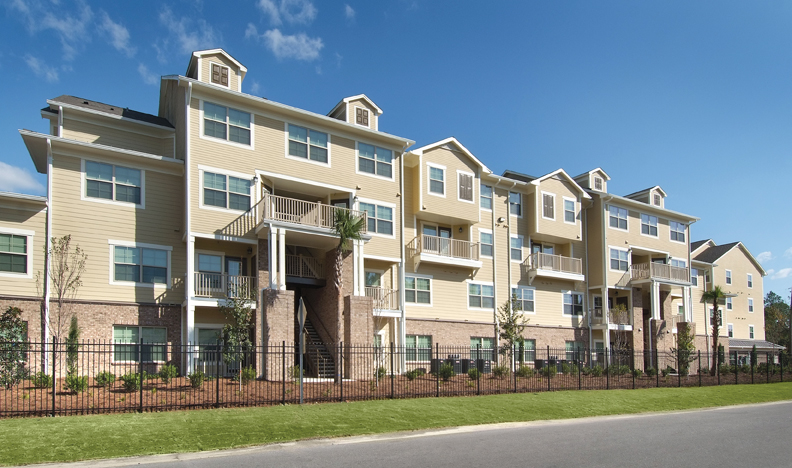As we noted in our July Giants 300 Report, multifamily construction, especially apartment buildings, has been the “darling” of the real estate industry in the last couple of years—and sustainably designed projects are contributing to that boom, even in places you might not think of finding them.
In Portland, Maine, the Oak Street Lofts have become the first affordable multifamily housing to earn LEED Platinum certification in the Pine Tree State. Designed by CWS Architects, the 37 artist-friendly efficiency apartments are 40% more energy efficient than the typical multifamily building. Wright-Ryan Construction (GC) diverted more than 60% of construction waste from landfill.
Thornton Tomasetti/Fore Solutions, acting as sustainability/LEED for Homes consultant, used energy modeling to analyze window glazing types, solar thermal water heating, and a heat-recovery ventilation system, along with envelope design to improve thermal breaks at the exterior wall.
In Panama City, Fla., Hardin Construction teamed with Chap Ashmore & Associates and architect Martin Riley Associates on the 92-unit Panama Commons, the first family-oriented affordable housing community in the Southeast to earn Platinum in the LEED for Homes program.
This was the twelfth project Hardin Construction has completed for the Paces Foundation. Hardin also constructed Galleria Manor, an 88-unit seniors-housing complex in Smyrna, Ga., and Whitehall Manor, in Cleveland, Ga., for the nonprofit housing development corporation. Both projects earned LEED Gold.
Green multifamily developments are also sprouting up in more traditional locales. In New York, construction is under way at 211 East 13th Street on an eight-story condominium development designed by BKSK Architects. The 110,000-sf, 83-unit tower, designed to LEED Silver standards, features a stormwater filtration system—considered unusual for an urban project—and both a blue roof (to store rainwater) and a green vegetated roof to relieve the overtaxed sewer system. +
Related Stories
Lighting | Mar 4, 2024
Illuminating your path to energy efficiency
Design Collaborative's Kelsey Rowe, PE, CLD, shares some tools, resources, and next steps to guide you through the process of lighting design.
MFPRO+ News | Mar 1, 2024
Housing affordability, speed of construction are top of mind for multifamily architecture and construction firms
The 2023 Multifamily Giants get creative to solve the affordability crisis, while helping their developer clients build faster and more economically.
Multifamily Housing | Feb 29, 2024
Manny Gonzalez, FAIA, inducted into Best in American Living Awards Hall of Fame
Manny Gonzalez, FAIA, has been inducted into the BALA Hall of Fame.
K-12 Schools | Feb 29, 2024
Average age of U.S. school buildings is just under 50 years
The average age of a main instructional school building in the United States is 49 years, according to a survey by the National Center for Education Statistics (NCES). About 38% of schools were built before 1970. Roughly half of the schools surveyed have undergone a major building renovation or addition.
MFPRO+ Research | Feb 28, 2024
New download: BD+C's 2023 Multifamily Amenities report
New research from Building Design+Construction and Multifamily Pro+ highlights the 127 top amenities that developers, property owners, architects, contractors, and builders are providing in today’s apartment, condominium, student housing, and senior living communities.
AEC Tech | Feb 28, 2024
How to harness LIDAR and BIM technology for precise building data, equipment needs
By following the Scan to Point Cloud + Point Cloud to BIM process, organizations can leverage the power of LIDAR and BIM technology at the same time. This optimizes the documentation of existing building conditions, functions, and equipment needs as a current condition and as a starting point for future physical plant expansion projects.
Data Centers | Feb 28, 2024
What’s next for data center design in 2024
Nuclear power, direct-to-chip liquid cooling, and data centers as learning destinations are among the emerging design trends in the data center sector, according to Scott Hays, Sector Leader, Sustainable Design, with HED.
Windows and Doors | Feb 28, 2024
DOE launches $2 million prize to advance cost-effective, energy-efficient commercial windows
The U.S. Department of Energy launched the American-Made Building Envelope Innovation Prize—Secondary Glazing Systems. The program will offer up to $2 million to encourage production of high-performance, cost-effective commercial windows.
AEC Innovators | Feb 28, 2024
How Suffolk Construction identifies ConTech and PropTech startups for investment, adoption
Contractor giant Suffolk Construction has invested in 27 ConTech and PropTech companies since 2019 through its Suffolk Technologies venture capital firm. Parker Mundt, Suffolk Technologies’ Vice President–Platforms, recently spoke with Building Design+Construction about his company’s investment strategy.
Performing Arts Centers | Feb 27, 2024
Frank Gehry-designed expansion of the Colburn School performing arts center set to break ground
In April, the Colburn School, an institute for music and dance education and performance, will break ground on a 100,000-sf expansion designed by architect Frank Gehry. Located in downtown Los Angeles, the performing arts center will join the neighboring Walt Disney Concert Hall and The Grand by Gehry, forming the largest concentration of Gehry-designed buildings in the world.
















